Identification of Virginia’s Noxious Weeds
ID
SPES-244NP (SPES-502NP)
Introduction
In 2018, giant hogweed was found in Virginia. Giant hogweed is dangerous and harmful to humans if proper care is not taken for the removal and destruction of this weed species. Giant hogweed is one of the many examples of how potentially dangerous noxious weeds can be and why it is important to recognize and use proper care when encountering noxious weeds. The Virginia Department of Agriculture and Consumer Services (VDACS) defines a noxious weed as any living plant, or part thereof, declared by the Board through regulations under this chapter to be detrimental to crops, surface waters, including lakes, or other desirable plants, livestock, land, or other property, or to be injurious to public health, the environment, or the economy, except when in-state production of such living plant is commercially propagated in Virginia. Weeds deemed noxious are split into three tiers by VDACS: Tier 1 being defined as “any noxious weed that is not known to be present in the Commonwealth”, Tier 2 as “any noxious weed that is present in the Commonwealth and for which successful eradication or suppression is feasible”, and Tier 3 as “any noxious weed (i) that is present in the Commonwealth, (ii) whose spread may be slowed by restrictions on its movement, and (iii) for which successful eradication or suppression is not feasible.”
This publication provides information on identification characteristics of Virginia’s noxious weeds and proper actions that should be taken if a person believes this weed is growing on their property or if they encounter one of these weeds in nature.
Tier 1 Noxious Weeds
Giant hogweed Heracleum mantegazzianum
Giant hogweed was first discovered in Virginia in 2018 in the mountain/valley region. There has been no evidence of giant hogweed spread in the state meaning that each instance where it has been located it was planted there (Flessner and Metzgar 2018).
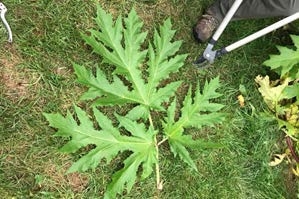
Giant hogweed can be dangerous in certain situations. If sap contacts the skin in the sunlight, it can result in severe burning and blistering (Nielson et al. 2005). Giant hogweed typically grows to be 6-8 feet tall but can grow to as tall as 18 feet with leaves as wide as 8 feet, stems up to 6 inches across, and flowers clustered up to 1.5 feet across. Leaves can appear similar to cow parsnip (Heracleum maximum), but giant hogweed leaves have acute lobes (figures 1 and 2) (Flessner and Metzgar 2018; Weakley 2015). Giant hogweed can also appear similar to poison hemlock (Conium maculatum), wild carrot (Daucus carota), and other species (figures 3 and 4). Consult Virginia Cooperative Extension Publication SPES-48NP for more information: Giant hogweed is also a Federal noxious weed.
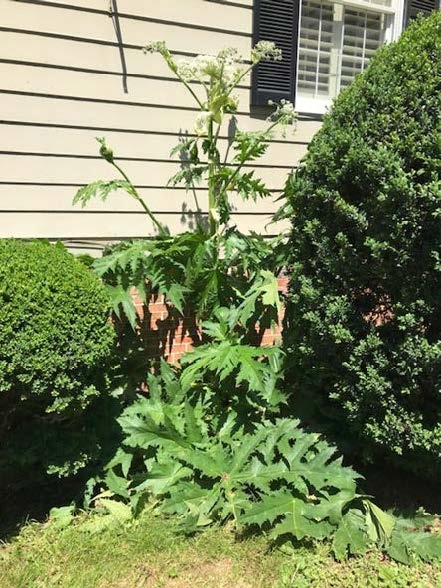
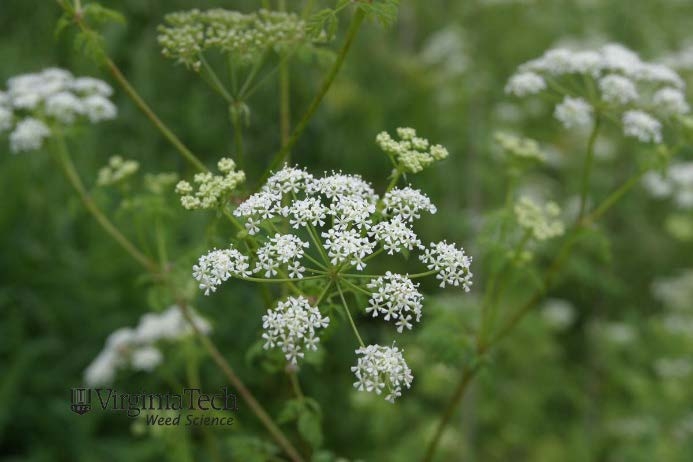
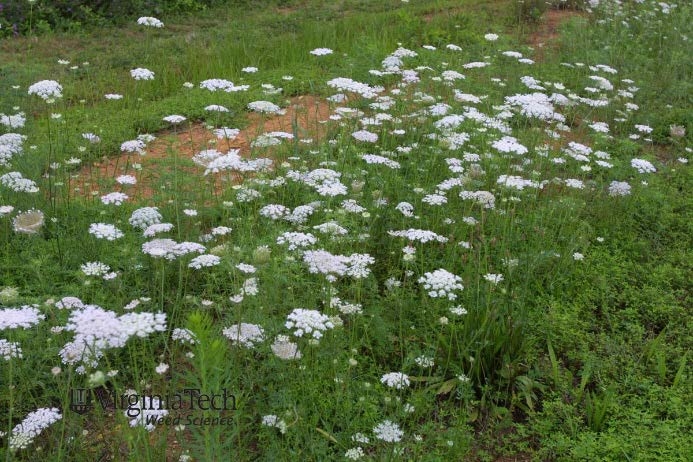
Giant Salvinia Salvinia molesta
Giant Salvinia is an aquatic weed species that floats on the surface of ponds, lakes, and other bodies of water (figures 5 and 6). This invasive species is non- native and is not widespread. It was found and eradicated in Shenandoah County but is present in Washington D.C. (USDA Plants Database). It has horizontal stems below the water surface and a trio of leaves that form from each node. There are two green, oval-shaped leaves above the water surface with the third leaf being brown and under the surface (Thayer 2020). Giant Salvinia can form a dense blanket across the water surface, damaging aquatic ecosystems by replacing native, desirable plants that are crucial for the survival of animals and waterfowl (Anonymous a). Giant Salvinia is also a Federal noxious weed.
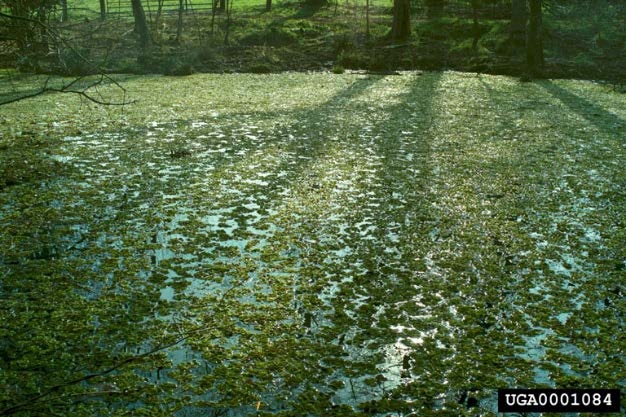
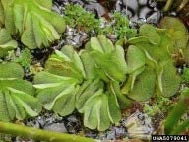
Tropical soda apple Solanum viarum
Tropical soda apple is a perennial shrub that affects much of the southeastern United States. It typically impacts pastures or other areas of forage and is undesirable to animals (Mullahey 2012). Tropical soda apple can reach up to 6 feet tall. It is a broadleaf species with leaves that are 6-8 inches long and 2-6 inches wide. Leaves are similar in appearance to oak leaves and have prickles that form on most of the plant (figures 7 and 8). Flowering can occur year- round with reproduction typically occurring from September through May. Flowers are white, with five petals and a yellow center that forms a point. It produces a fruit that resembles a tiny watermelon (Anonymous 2018a).
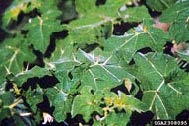
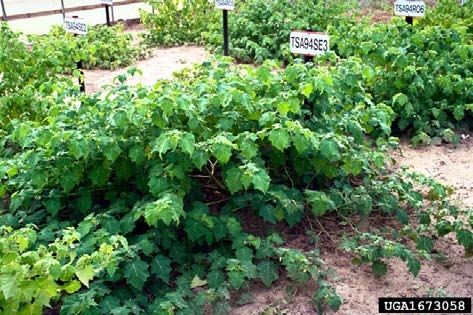
Horsenettle (Solanum carolinense) is a related native species similar in appearance to tropical soda apple, but horsenettle’s leaves, fruits, and size are all smaller (figure 9). Tropical soda apple is also a Federal noxious weed.
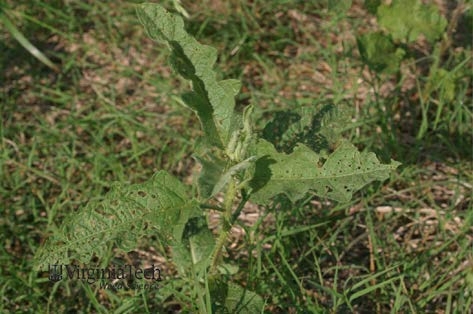
Tier 2 Noxious Weeds
Beach vitex Vitex rotundifolia
Beach vitex is a woody shrub with circular leaves typically found on coastlines. Leaves can be 1-1.5 inches long and form in pairs along the stem. The leaves are smooth and if crushed, produce a spicy fragrance. Plants will flower in early May with most of the flowers being towards the top of the plant. The flowers will fall off and a green, circular fruit is left attached to the plant. As winter draws nearer, the fruit will dry and turn black (Gresham 2017). It is found near Virginia Beach, Tidewater, and other areas with sandy soil.

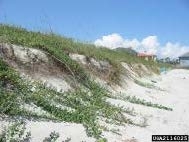
Cogongrass Imperata cylindrica
Cogongrass is an invasive species found in much of the southern United States. It grows in dense patches and can become quite tall (up to 6 feet) (figure12).
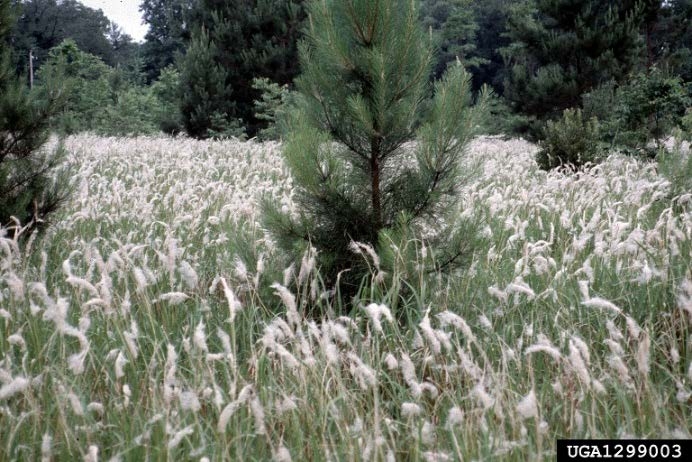
It is found throughout the state of Virginia (USDA Plants Database). Eastern gammagrass (Tripsacum dactyloides), foxtails (Setaria spp.), and other grasses may appear similar to cogongrass, but do not have the off-set midrib. Cogongrass is also a Federal noxious weed.
Leaf blades can be up to 6 feet in length and 1 in wide. It has a highly visible line (midrib) off-set from the center of the leaf (figure 13). Typically, cogongrass is light green-yellow. After the first frost or freeze, leaves can turn reddish or brown. Seedheads are white or silver and can be from 2-8 inches in length and typically blooms from March through June (Anonymous 2018b).
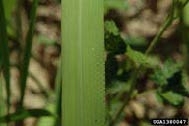
Incised fumewort Corydalis incisa
Incised fumewort has been reported in Albemarle and Fairfax counties in Virginia (EDDMapS 2020). It is a biennial that can grow up to 2 feet tall. There are large serrations on the leaves and leaves can be 1.5-5 inches in length and width (figures 14 and 15). The flower is purple but can also be white. Flowers are approximately 0.5 inches long and petals are not fused. On each flower stalk, there is a green capsule- like fruit that contains seeds. A similar species is yellow fumewort (Corydalis flavula), but it is native to the United States and has yellow flowers (Ossi 2017).
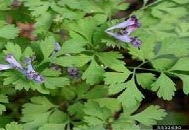
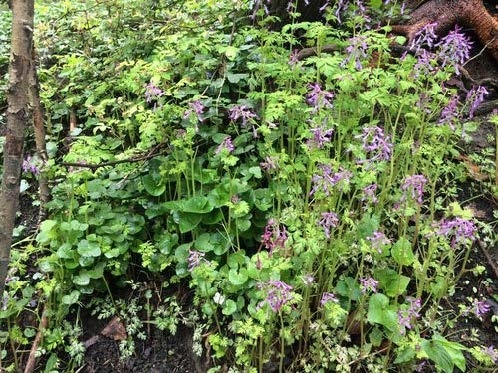
Purple loosestrife Lythrum salicaria
Purple loosestrife is present in most regions of Virginia except Southside and the Eastern Shore (USDA Plants Database). It is typically found in high moisture areas and can be nearly five feet tall (figure 16). Leaves are usually in pairs, but sometimes in groups of three arranged opposite of each other along the stem. Leaves sometimes appear whorled. The stem is square-shaped but sometimes six-sided (figure 17). Flowers are purple and can be 0.2-0.4 inches in length and have 5-7 petals (Anonymous b) (figure 18). Fireweed (Chamerion angustifolium) looks similar to purple loosestrife but has a round stem.

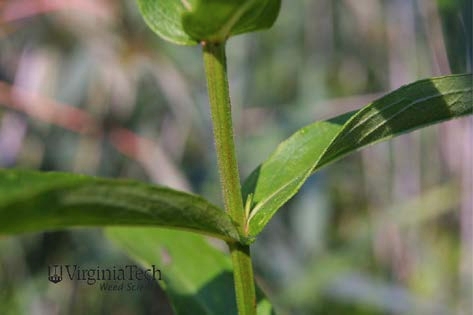
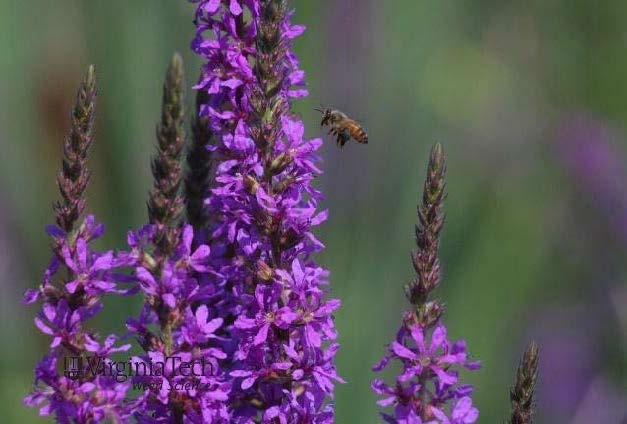
Water spinach Ipomoea aquatica
Water spinach is an aquatic species typically found in the southern United States. It is a vine with a milky sap and floats on the surface of water (figure 20). Leaves are typically 1-6 inches long with the leaves above the water often being a little longer. Flowers resemble morningglories (Ipomoea spp. L.) and are typically white or pink (figure 19). It produces a small fruit that resembles a sphere and is typically around 0.4 inches wide (Richard and Ramey 2007). Water spinach is also a Federal noxious weed.
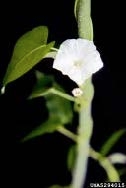
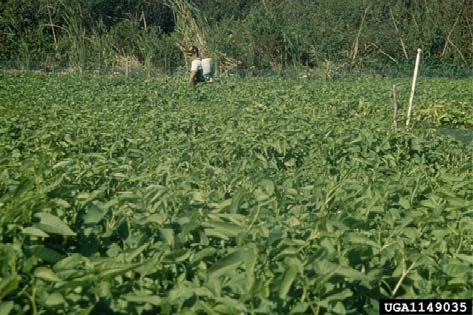
Wavyleaf basketgrass Oplismenus hirtellus
Wavyleaf basketgrass has been found in multiple counties in Virginia including Rockingham, Page, Greene, Madison, Warren, Fauquier, Clarke, Culpeper, Fairfax, Spotsylvania, Albemarle, Nelson, Augusta, Rappahannock, Arlington, Loudon, Prince William, Stafford, Powhatan, Fredrick and Rockbridge (Anonymous 2019). Wavyleaf basketgrass leaves are dark green and are typically 1.5-4 inches long and 0.5 inches wide (figure 21). Leaf sheaths are hairy and the plant blooms from September through November (Westbrooks and Imlay, 2009). Seedheads have long, sticky awns that cling to boots, clothing, animals, and anything passing by (figure 22).
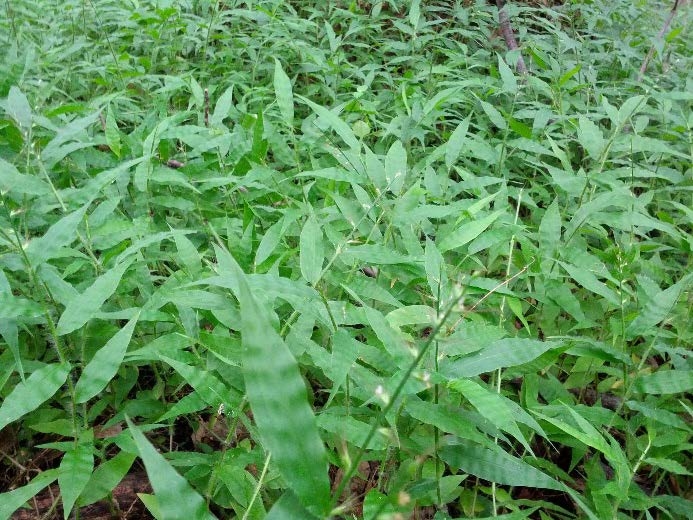
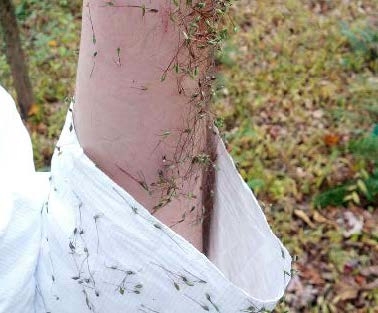
Wavyleaf basketgrass is similar to another invader, Japanese stiltgrass (Microstegium vimineum), but Japanese stiltgrass has silver hairs down the midveins of leaves and comes to a blunt end (figure 23). Whereas, wavyleaf basketgrass leaves are wavy, as the name implies, across their width and come to a sharp point. Jointhead arthraxon (Arthraxon hispidus) can also appear similar, but only the leaf edges are wavy (figure 24).

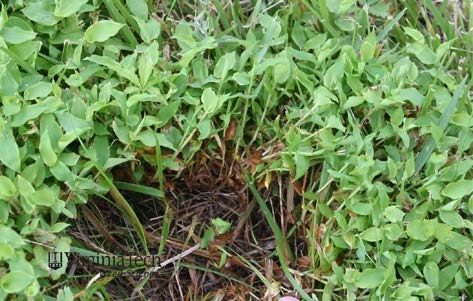
Tier 3 Noxious Weeds
Hydrilla Hydrilla verticillata
Hydrilla is known to occur in Brunswick, Fairfax, Fauquier, Louisa, and Mecklenburg Counties (USDA Plants Database). Hydrilla is a submersed aquatic weed but can reach the surface of water and form a mat (figure 25). Stems are underwater and can reach up to 25 feet in length. Branching occurs near the surface of water. Leaves are small with pointed tips (figure 26). They are arranged in whorls of 4-8. Leaf margins are sharp with saw-tooth serrations. Leaves are green, but those on the surface can be bleached by the sun or be subject to fungus and disease, making them appear yellow or brownish-green. Hydrilla is dioecious. Female flowers are white, solitary, and float on the surface. Male flowers are green and are attached to the stem tips. Male flowers eventually break loose and fertilize the female flower when they come in contact (Ramey and Peichel, 2001). Hydrilla is also a Federal noxious weed.
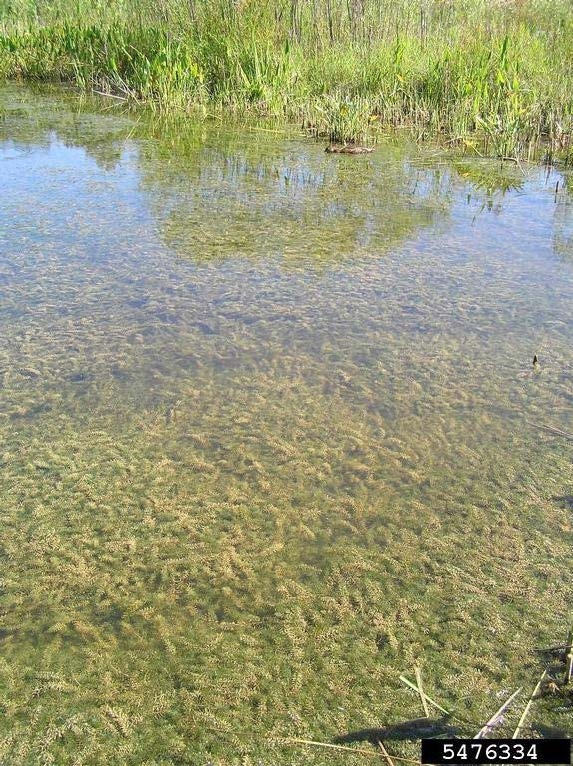
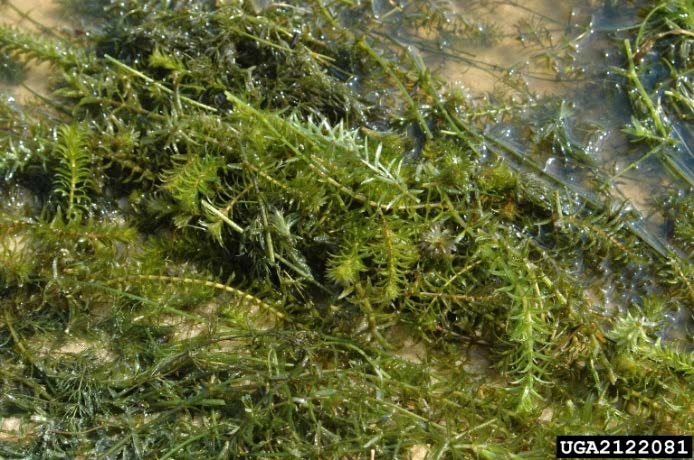
Mile-a-minute Persicaria perfoliata
Mile-a-minute is known to be present in Fairfax, Loudoun, Prince William, Fauquier, Warren, Rappahannock, Culpepper, Madison, Louisa, Carroll, and Grayson Counties and the cities of Richmond and Suffolk (EDDMapS). Mile-a-minute weed is common in high moisture areas and the vine can grow to 20 feet in length. Leaves are uniquely triangular and are 1-3 inches in length (figure 27). Leaves are light green in the summer months and turn reddish-brown in the winter months (figure 28). Stems have sharp spikes and unique round leaf-like structures encircle the stem at intervals. Flowers are white that are borne on short spikes. Fruits are small, berrylike fruits that are blue. Seeds can be spread easily, and it grows extremely quickly (Anonymous c).
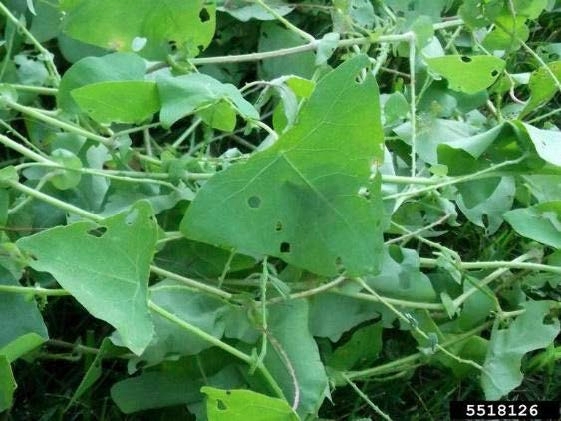
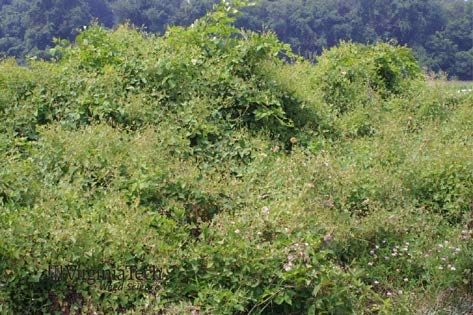
VDACS is actively releasing the mile-a-minute weevil (Rhinoncomimus latipes) that feed on the plant to help control it (figure 27). Mile-a-minute can resemble two other Persicaria spp.: arrow-leaved tearthumb (Persicaria sagittate) and halberdleaf tearthumb (Persicaria arifolia) but neither has the unique circular leaf-like structures along the stem (figures 29 and 30).
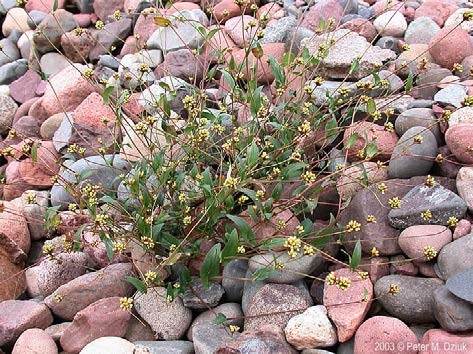
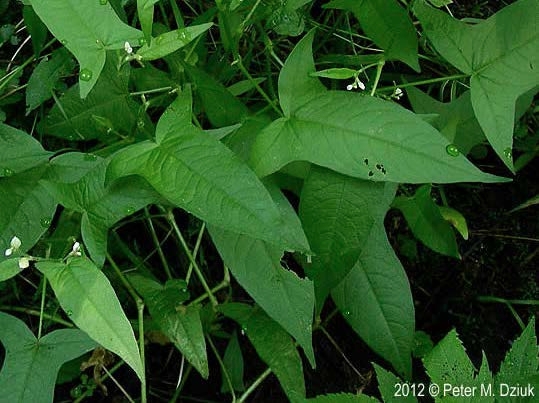
Oriental bittersweet Celastrus orbiculatus
Oriental bittersweet is known to occur along the I-64 and I-81 corridors, Northern Virginia, as well as other locations (USDA Plants Database). Oriental bittersweet is a deciduous, climbing, woody vine. It can grow up to 60 feet in length and up to 4 inches in diameter. The bark is often brown to dark brown and the twigs are gray to dark brown. Leaves are alternate and circular in shape (figures 31 and 32). They are typically light green and can be from 2-5 inches in length. Flowers are small and greenish-white. They bloom from May through early June. When fruit is young, they are green and then turn yellow as they mature. When fruits reach maturity, they split and reveal scarlet berries that remain into winter. It is commonly growing on old homes, fields and road edges (Anonymous, 2018d). Oriental bittersweet is commonly mistaken for the native American bittersweet (Celastrus scandens). The key identification characteristics to distinguish between the two are on oriental bittersweet, the flowers and fruits will grow throughout the length of the stem while American bittersweet flowers and fruits exclusively grow in clusters (USDA 2007). Furthermore, fruits on oriental bittersweet are yellow while fruits on American bittersweet are orange and pollen from oriental bittersweet is white while American is yellow (USDA 2007).
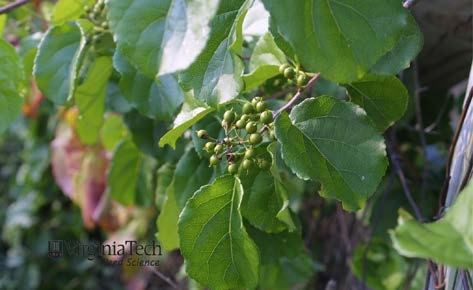
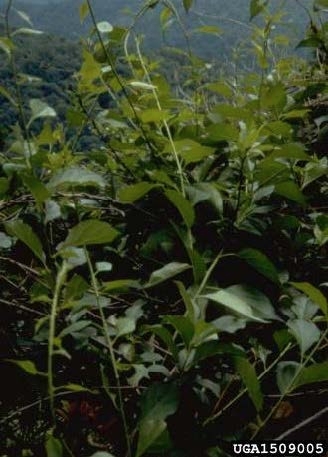
Porcelain berry Ampelopsis brevipedunculata
Porcelain berry is known to occur in and around Richmond and Northern Virginia as well as Albemarle and Westmoreland Counties (USDA Plants Database). Porcelain berry is a vine that climbs trees (figure 33, similar to kudzu (Pueraria montana var. lobata). Leaves are alternate and have heart- shaped bases (figure 34). Green/white flowers will appear from June through August and grape-like fruits will be produced. It will complete maturity from August through September. It grows quickly along forests, ponds, and streambanks and seeds are spread by water, birds, and other natural occurrences (Anonymous d). Native grapes (Vitis spp.) may look similar, but the stem center (pith) is brown in grapes while white in porcelain berry.
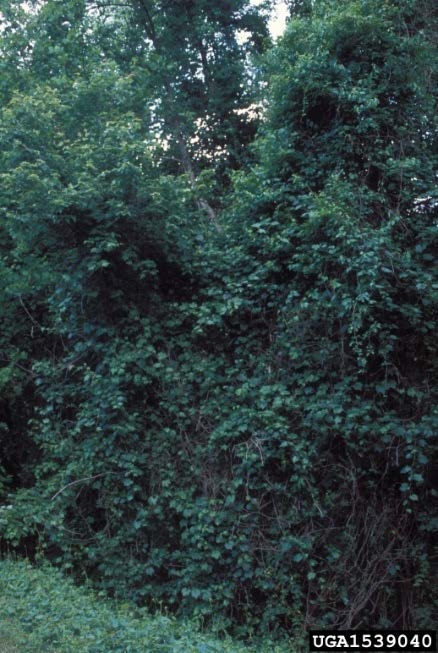
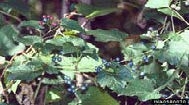
Tree of heaven Ailanthus altissima
Tree of heaven (figure 35) has been located in nearly every county in Virginia (USDA Plants Database). It is the preferred host for spotted lanternfly, an invasive insect. It is a rapidly growing dioecious tree, growing as tall as 100 feet and 6 feet in diameter. A young tree will have green bark but as it ages will become brown and sometimes gray. Leaves grow from a central stem and can be anywhere from 1-4 feet long and each can contain 10-40 leaflets (figure 36). At each leaflets base, there is a bump and when penetrated will release a vile odor. On female trees, there is a fruit that is 1-2 inches long. Each fruit contains one seed and fruits are in clusters and hang on the tree through winter. It is a prolific seeder and new shoots can grow from roots, giving rise to new plants. Tree of heaven can look like staghorn sumac (Rhus typhina), black walnut (Juglans nigra), or hickory (Carya ovata), but each of those have serrations on leaflet edges while tree of heaven does not (Jackson and Grover 2018).
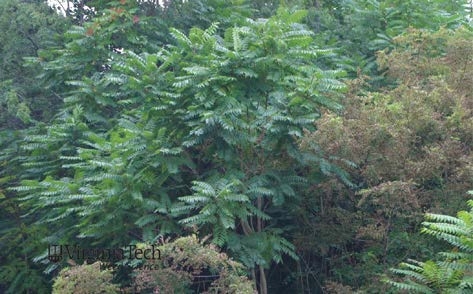
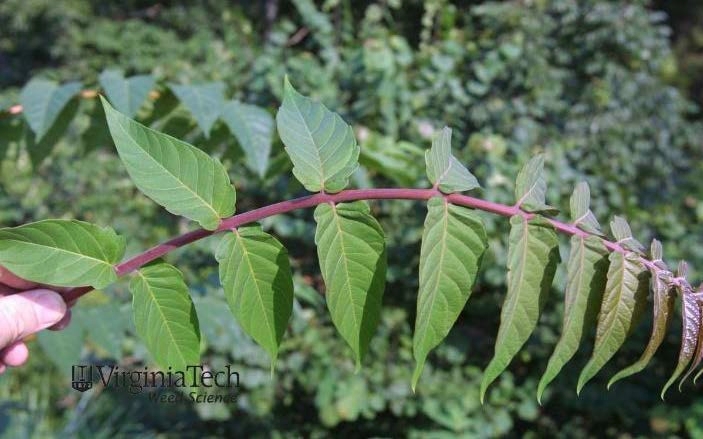
Subsequent Actions
If you believe you have one of the Tier 1 or 2 noxious weeds mentioned above, it is important to contact your local county extension office (https://ext.vt.edu/offices.html) or VDACS at NoxiousWeed.VDACS@vdacs.virginia.gov to verify identification. Do not transport any viable plant part of the weed without first obtaining a permit from VDACS as this is required by Virginia law (http://www.vdacs.virginia.gov/pdf/noxious-weed- permit.pdf). After identification, your county extension agent or VDACS representative for Tier 1 and 2 weeds will work to form a control plan.
Identification and control of noxious weeds is crucial for preservation of ecosystems and for the overall well-being of people that have this weed on their property.
Controlling Tier 3 noxious weeds can be challenging but worthwhile to protect the local environment. Consult the Additional Resources below to find information on controlling these weeds.
Additional Resources
Heffernan, K.E. 1998. Managing Invasive Alien Plants in Natural Areas, Parks, and Small Woodlands. Natural Heritage Technical Report 98-25. Virginia Department of Conservation and Recreation, Division of Natural Heritage.
Richmond, Virginia. https://www.dcr.virginia.gov/natural-heritage/document/mnginv.pdf
Virginia Cooperative Extension Local Offices: https://ext.vt.edu/offices.html
Virginia Cooperative Extension Pest Management Guides: https://www.pubs.ext.vt.edu/pmgstore.html
Acknowledgments
Tina MacIntyre with Virginia Department of Agricultural and Consumer Services.
References
Anonymous (a). Giant Salvinia. United States Department of Agriculture. https://www.invasivespeciesinfo.gov/profile/giant-salvinia
Anonymous. 2018a. Tropical soda apple. Invasive Plant Atlas of the United States. https://www.invasiveplantatlas.org/subject.html?sub=2446
Anonymous. 2018b. Key Identification Features of Cogongrass. Center for Invasive Species and Ecosystem Health, University of Georgia. https://www.cogongrass.org/identification/
Anonymous (b). Weed Identification. Virginia Tech College of Agriculture and Life Sciences. https://weedid.cals.vt.edu/
Anonymous (c). Mile-a-minute. Ohio’s Noxious Weeds. Pressbooks. https://ohiostate.pressbooks.pub/ohionoxiousweeds/chapter/mile-a-minute/
Anonymous (d). Invasive, Exotic Plants of the Southeast-Porcelain berry. Going Native, North Carolina State University Extension. https://plants.ces.ncsu.edu/plants/ampelopsis-brevipedunculata/
Anonymous. 2018d. Oriental bittersweet. Invasive Plant Atlas of the United States. https://www.invasiveplantatlas.org/subject.html?sub=3012
Anonymous. 2019. DCR Wavyleaf Grass Public Map. https://www.dcr.virginia.gov/natural- heritage/document/fswavy.pdf
EDDMapS. 2020. Early Detection & Distribution Mapping System. The University of Georgia - Center for Invasive Species and Ecosystem Health. Available online at https://www.eddmaps.org/
Flessner, M. L., J. Metzgar. 2018. Giant Hogweed: Identification and Control. Virginia Cooperative Extension. https://www.pubs.ext.vt.edu/content/dam/pubs_ext_vt_edu/spes/spes-48/SPES-245.pdf
Gresham, C. A. 2017. Identifying and Managing Beach Vitex. Factsheet. Home and Garden Information Center, Clemson Cooperative Extension. Pub. No: HGIC 2315 https://hgic.clemson.edu/factsheet/identifying-managing-beach-vitex/
Jackson, D. A. Grover. 2018. Tree-of-Heaven. Penn State Extension. https://extension.psu.edu/tree-of-heaven
Mullahey, J. 2012. Solanum varium. Center for Aquatic and Invasive Plants. University of Florida. http://plants.ifas.ufl.edu/plant-directory/solanum-viarum/#III
Nielsen C, Ravn HP, Nentwig W, Wade M. The Giant Hogweed Best Practice Manual, Guidelines for the management and control of invasive weed in Europe. Hoersholm: Forest & Landscape Denmark; 2005.
Ossi, D. 2017. An Incisive Invader. Maryland Invasive Species Council. http://mdinvasives.org/iotm/may-2017/
Ramey, V. B Peichel. Hydrilla Verticillata. Center for Aquatic and Invasive Plants, University of Florida. http://plants.ifas.ufl.edu/plant-directory/hydrilla-verticillata/
Richard, A., V. Ramey. 2007. Invasive and Non- Native Plants You Should Know, Recognition Cards. UF/IFAS Center for Aquatic and Invasive Plants, Pub. No. SP 431.
Thayer, D.D., I.A. Pfingsten, C.C. Jacono, M.M. Richerson, and V. Howard, 2020, Salvinia molesta Mitchell: U.S. Geological Survey, Nonindigenous Aquatic Species Database, Gainesville, FL, https://nas.er.usgs.gov/queries/FactSheet.aspx?speciesID=298, Access Date: 4/15/2020
USDA. Introduced, Invasive, and Noxious Plants. https://plants.usda.gov/java/noxious
USDA, NRCS. 2020. The PLANTS Database (https://plants.usda.gov, 21 July 2020). National Plant Data Team, Greensboro, NC 27401-4901 USA.
USDA. 2007. American and Oriental Bittersweet Identification. https://www.fs.usda.gov/Internet/FSE_DOCUMENTS/fsbdev3_017307.pdf
Virginia Department of Agriculture and Consumer Services. Noxious Weeds. https://www.vdacs.virginia.gov/plant-industry-services-noxious-weeds.shtml
Virginia Law. 2VAC5-317-10. Definitions. Internet. Available: https://law.lis.virginia.gov/admincode/title2/agency5/chapter317/section10/
Weakley, A.S. 2015. Flora of the southern and mid-Atlantic states, working draft of May 2015.
Westbrooks, R. M Imlay. 2009. Wavyleaf Basketgrass-A New Invader of Deciduous Forests in Maryland and Virginia. https://www.seeppc.org/southcarolina/WLBG.pdf
Virginia Cooperative Extension materials are available for public use, reprint, or citation without further permission, provided the use includes credit to the author and to Virginia Cooperative Extension, Virginia Tech, and Virginia State University.
Virginia Cooperative Extension is a partnership of Virginia Tech, Virginia State University, the U.S. Department of Agriculture (USDA), and local governments, and is an equal opportunity employer. For the full non-discrimination statement, please visit ext.vt.edu/accessibility.
Publication Date
May 17, 2023



